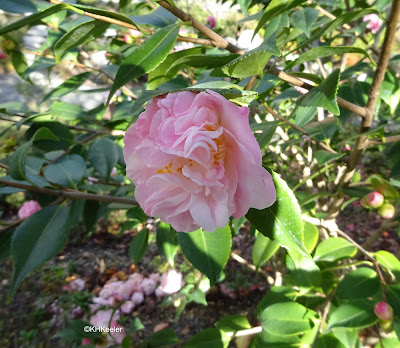I started this blog in February 2013. I have uploaded a post every week since then, 521 posts. The actual total is 532, because once in a while I added a mid-week post. In that decade I wrote books about conspicuous plants (listed below), gave talks about plants and travel, and, last month, published an historical novel about travel, featuring plants (see below). I learned a lot about writing, publishing, and projectors. I aspired to being an expert on a tour and just before covid, got to try it. Then, of course, I experienced staying in during the pandemic and, lately, reestablishing pre-pandemic activities. My thinking about plants went from considering all plants cool to believing we should make a real effort to grow plants native to our local area to preserve them and the animals that feed on them, which discourages growing nonnative plants.
 |
| In 2013 I saw the Caribbean for the first time. |
Ten years is a long time. In that time I took 20,000 photos (19,715 on plants and travel). I have not made time to label all of them. I took lots of photos of plants I like, such as camellias, blanket flowers (Gaillardia) and frangipani (Plumeria), and not enough photos of plants I think of as really ordinary, such as roses, Russian olives (Elaeagnus angustifolia), and common junipers (Juniperus communis), or of plants I would like to write about, for example, eggplants (Solanum melongena), turnips (Brassica rapa), and knotweeds (Polygonum species).
 |
| Another camellia, but isn't it beautiful? (Photo from 1/23) |
In those ten years I learned I like writing, a lot. It raises my mood to settle down to draft or revise a blog post or other writing project. I read about writer's block and wonder. Perhaps writing has become work for writers who are blocked; for me it is focused play, and a joy. But I have the freedom to scrap the blog that isn't working and write another one. I do have would-be posts that have remained drafts for years.
I'm looking forward to more years of writing this blog. Another ten years, God willing. I won't run out of plants to profile in my lifetime. My travel is slowing, from the pandemic and its lingering effects, and because, after 15 years of energetic travel, my husband and I are less eager to throw ourselves into a new adventure if it involves three airline flights over most of 24 hours. We'll see what we come up with in the coming years. There will always be botanical and ecological concepts to describe and discuss.
Blogs are old at two years, I suspect. I should update some of mine. For example, I recently read studies that demonstrate that deathcamas (Toxicoscordion) has few pollinators because its toxin, zigacine, poisons, and sometimes kills, common native bees, whether they drink nectar or gather pollen. Only one bee, Adrena astragali, pollinates without being harmed. It was easy to observe deathcamas plants flowering without insects visiting it, but now we start to understand why. But, alas, I find it more fun to explore something new than modify old posts. And its about fun.
 |
| Japanese Garden, Balboa Park, San Diego, Jan. 2023. |
Vacation Notice: All that said, I'm giving myself a vacation from the blog for two weeks. I have observed that breaks in routine are rejuvenating. This blog will begin its second decade on February 26th.
Things Mentioned:
Books I've published this decade, listed as by Kathy Keeler or Kathleen Keeler:
Plant Stories Like this Blog or From this Blog:
Curious Stories of Familiar Plants from Around the World (2014) link
Curious Stories of Familiar Garden Plants (2016) link
NoCo Notables: 15 Wild Northern Colorado Worth Knowing (2017) link
Look Twice: 15 Plants to Notice at Lake McConaughy (2018) link
Fiction:
I Have Seen Marvels, A Journey to Paraguay, 1630 (2023) link
Deathcamas paper that will lead you to other studies:
Cane, J.H., D.R. Gardner, and M. Weber. 2020. Neurotoxic alkaloid in pollen and nectar excludes generalist bees from foraging at death-camas, Toxicoscordion paniculatum (Melanthiaceae). Biological Journal of the Linnean Society. 131: 927-935. link (Accessed 2/4/23).
Comments and corrections welcome.
No comments:
Post a Comment